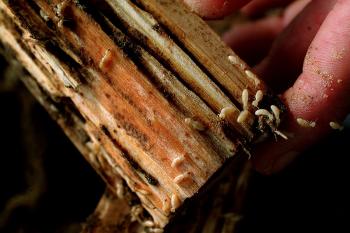
A wooden stick that had been buried in the ground in a “crate bait” for one month is teeming with Formosan subterranean termites. Scientists use the baits to capture termites that are then used for research. A 1-foot-square crate with 40 sticks can attract as many as 30,000 termites in a week.
--LSU AgCenter Photo
Formosan termite numbers rising
BATON ROUGE — Mimicking the growing population of East Baton Rouge Parish, the number of Formosan subterranean termites found in traps across the area is also increasing.
This should be taken as a warning sign for homeowners because these termites are responsible for more than $300 million in losses every year in the Greater New Orleans region, said LSU AgCenter entomologist Gregg Henderson.
“Since 2009, we have been light trapping at several locations across the parish. We have seen a fairly significant increase every year but one, and during that year drought conditions existed which does affect the alates — or winged termites,” Henderson said.
The average number of alates per trap was 32 in 2009, he said. By 2014, the average number was 596.
Although the insects have wings, they are not good fliers. Henderson estimates that 300 yards is about the maximum distance they can travel by flying. Humans are more responsible for distributing the termites by moving wood-infested products than the termites are based on their own flights.
“The movement of infested material such as mulch, landscaping timbers and other wood-based items is the primary method for distributing Formosan termites,” Henderson said. “In fact, Formosan termites were found in Atlanta, Georgia, due to infested railroad ties being brought in for landscaping purposes. They actually did DNA testing to confirm they came from a New Orleans colony.”
A key factor in termite population growth is a readily available food source based on cellulose.
“Cellulose material is the most abundant organic matter on earth, and very few animals can digest it,” Henderson said. “Formosan termites also have bigger colonies than native subterranean termites and have the ability to digest more material, leading to greater structural damage.”
All termite species will infest living trees. Henderson has documented cypress trees along the Calcasieu River having carton nests of Formosan termites. As part of a research project, Henderson found 46 percent of the swamp maples in Sam Houston Jones State Park, north of Lake Charles, had Formosan termites.
“Swamp maples, red oaks and pecans are species of trees that the Formosans seem to prefer,” he said. “It appears that pine trees are one of the least preferred, and that probably has to do with the resins found in pine trees.”
Based on his research and observations, Henderson expects the Formosan termites to swarm in early to mid-May. During his light-trapping research, the earliest first documented swarm was on May 3 with the latest being May 22.
In 2014, “every light post along Staring Lane in Baton Rouge had Formosan termites swarming around them,” Henderson said. “The numbers were small, but in five years I expect those numbers to be much higher.”
Homeowners should be vigilant and be on the lookout for termite damage, he said. They should avoid moving material that is suspected of being infested, especially if the material comes from areas with high infestations such as New Orleans, Mandeville and Lake Charles.
Chemicals are effective in controlling termites if they get into a home, Henderson said. But it will take a professional pest control operator to do the job effectively. And, hopefully, they are discovered before they cause widespread damage.
--By CRAIG GAUTREAUX
LSU AgCenter
- Log in to post comments
